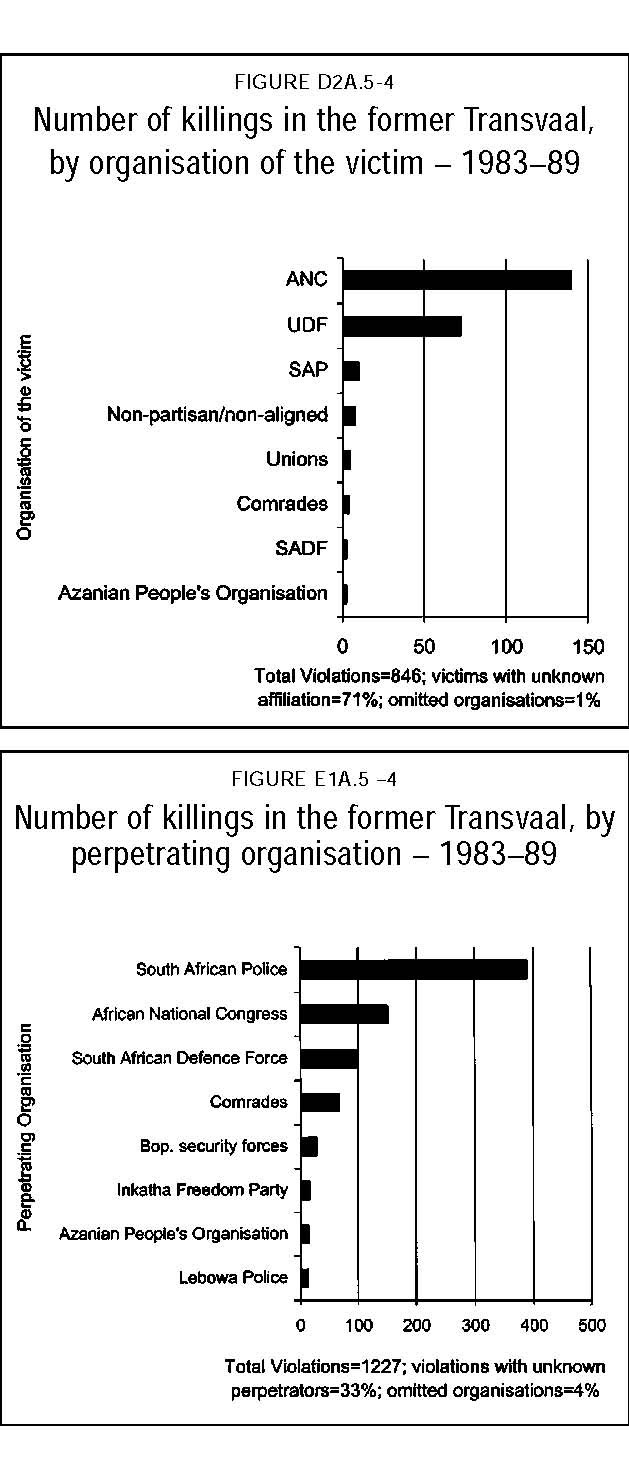 |
News | Sport | TV | Radio | Education | TV Licenses | Contact Us |
 |
News | Sport | TV | Radio | Education | TV Licenses | Contact Us |
TRC Final ReportPage Number (Original) 600 Paragraph Numbers 252 to 259 Volume 3 Chapter 6 Subsection 38 252 Most attacks on government representatives were carried out through petrol-bombing and arson. The most infamous form of violence, used primarily against alleged informers, was the necklace method. Research sources outside the Commission indicate that at least 400 fatal incidents of necklacing took between 1984 and 1990. Approximately 400 people were killed by being doused with petrol and set alight, or when their homes were petrol-bombed. Only about a quarter of these were reported to the Commission, along with approximately the same number of non-fatal arson attacks. A number of arson attacks targeted political activists. 253 Approximately 144 policemen were killed between 1984 and 1987. The majority of victims were black policemen who lived and worked in the townships where they were attacked. Only about ten of these killings were reported to the Commission. 254 The perpetrators of these attacks were generally youth, often referred to as ‘comrades’, who were aligned to the United Democratic Front (UDF) but not necessarily members or activists. Commission data shows more than fifty acts of killing carried out by ‘comrades’ in the former Transvaal during this period. 255 In the context of escalating conflict and social dislocation, young people gained increasing power, exacting retribution on councillors, police, alleged informers, business people, chiefs and others. This self-appointed policing role also included the violent enforcement of the UDF’s programmes such as consumer boycotts and stay aways. Those who violated these boycotts were exposed to summary punishment such as the forced consumption of toxic goods purchased in contravention of consumer boycotts. Others were brought before ‘people’s courts’, set up in the absence of legitimate government structures. These courts were increasingly commandeered by youth who exacted swift and violent penalties from those they found guilty of offences.  256 In its submission to the Commission, the UDF placed the gross human rights violations committed by its members and supporters into a context including factors such as political immaturity, a climate of mistrust and fear generated by state violence and disinformation campaigns, a militaristic culture, particularly amongst youth, and widespread detention of leaders who could have curbed excesses. The UDF also acknowledged that it encouraged the use of defensive violence when activists and leaders were violently attacked, and that some UDF leaders, particularly youth leaders, publicly promoted political intolerance. 257 This period was notable also for a shift in the nature of the ANC’s armed campaign within the country, largely in response to popular rebellion in the wake of the Vaal uprising. The new strategy involved the intensification of the organisation’s military and political offensive and an important policy shift regarding civilian casualties. The ANC stated that, although it would not directly target civilians, the risk of civilian casualties would not be allowed to stand in the way of intensified armed struggle. Civilian deaths and injuries would be an inevitable consequence of this policy. 258 It was in this context that a series of bombs were planted in urban centres such as Johannesburg and Pretoria and a landmine campaign launched in the border areas of the northern and eastern Transvaal in 1985. Approximately 130 people died, the majority of whom were black civilians. Commission data shows approximately 150 killings carried out by members of the ANC during this period in the former Transvaal. 259 Violent retaliation created a self-perpetuating cycle of violence which dramatically escalated levels of conflict in townships around the country. This included the use of violence in public order policing, and attacks by opposition groups on representatives of government authority. While the violent dispersal of political protest was intended to curb further political opposition, it frequently had the opposite effect and precipitated the mobilisation of entire communities. |